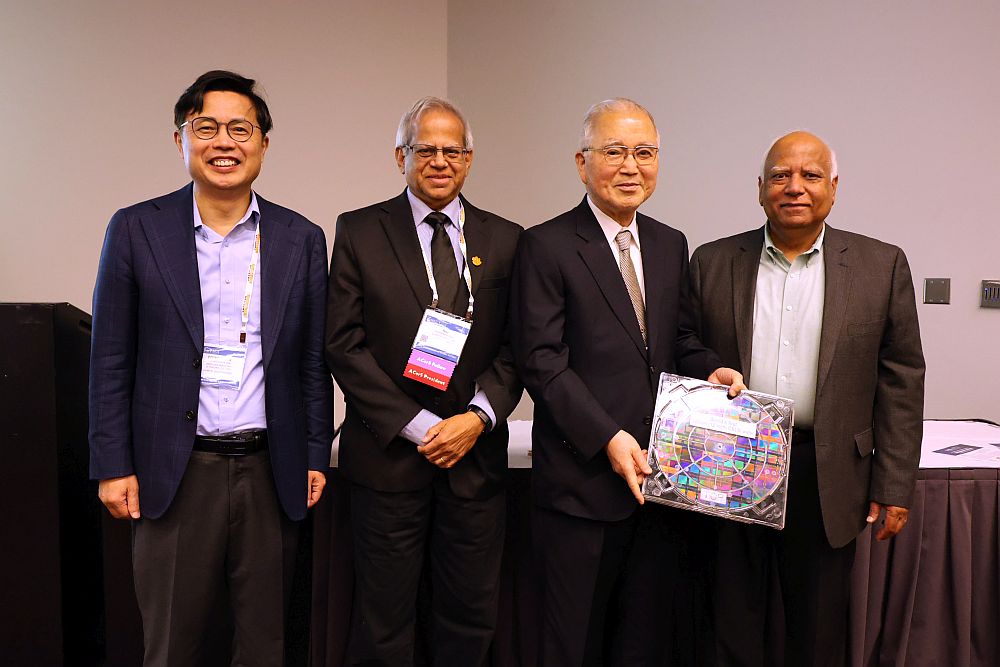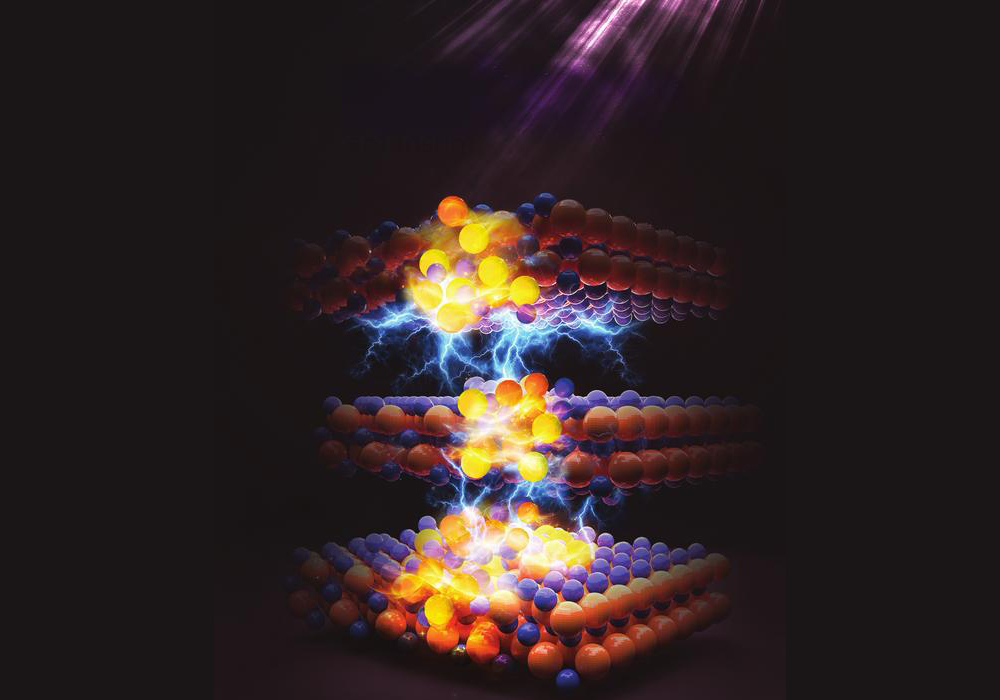
[Image above] Shunpei Yamazaki, second from right, shows off a replica of the first 300-mm indium oxide large-scale integrated wafer following his delivery of the Rustum Roy Lecture at MS&T24. Credit: ACerS
Since the 1970s, computer technology has advanced dramatically every decade. While these advancements have led to big gains in data storage and processing power, they have also greatly increased power consumption. As of 2023, data center demand globally hovered at 340 TWh—about 1.3% of worldwide electricity use.
With the advent of artificial intelligence, data center demand is expected to increase even more rapidly in the coming years. In a recent report, the International Energy Agency anticipates demand will more than double to 945 TWh by 2030.
Because most data centers currently rely on electricity generated using fossil fuels, this increased demand could contribute to a rise in greenhouse gas emissions. It is essential, then, that we find ways to curtail the power needed to run data centers while transitioning to a cleaner energy infrastructure.
Materials scientists know that materials play a big role in the power consumption and efficiency of computer systems. Developing new materials with better thermal and electrical properties than silicon, the current go-to material for electronic circuits, would allow us to meet data center demands but at a lower energy cost.
Six years ago, in the very first issue of ACerS’ gold open-access journal, International Journal of Ceramic Engineering & Science (IJCES), ACerS member Shunpei Yamazaki and his team from Semiconductor Energy Laboratory Co., Ltd. (Atsugi, Japan) reported about an advanced ceramic semiconductor that could replace silicon: c‐axis–aligned crystalline indium‐gallium‐zinc oxide (CAAC‐IGZO).
In that article, which was summarized on CTT, Yamazaki and his colleagues discussed the performance of oxide semiconductor field-effect transistors (OSFETs) based on CAAC-IGZO. These devices appeared to meet the four criteria of “universal memory” chips better than current technology.
“Universal memory” refers to single semiconductor chips that combine the low-power, long-term storage found in USB and SD cards with the rapid information exchange of random-access memory chips. CAAC-IGZO exhibits extremely low leakage current, which contributes to extremely high data retention, and also shows excellent read–write speeds and cycling ability. The high retention, which is on the order of 1,600 times longer than the current standard of 64 microseconds, is key to reducing power consumption by greatly reducing the refresh frequency needed to maintain high data quality.
Since that article was published, Yamazaki and his team have continued development of CAAC-IGZO and other materials for OSFETs, and they have chosen to share those results once again in the latest issue of IJCES.
In the new article, titled “Oxide ceramic large-scale integration device for putting the brakes on global boiling accelerated by artificial intelligence age computers,” they report on continuing development of CAAC-IGZO, but they also discuss another oxide semiconductor material: crystalline indium oxide (IO).
IO has even lower leakage current values than CAAC-IGZO, which the authors attribute to IO having fewer grain boundaries than CAAC-IGZO. Interestingly, though, CAAC-IGZO is an excellent template for depositing single crystals of IO into various chip technologies thanks to its chemistry, crystal structure, and lattice spacing.
There are several other differences between IO and CAAC-IGZO, which lead to each being preferred for different OSFET designs and applications. For example, IO is better suited for planar OSFET designs than for large-scale integration due to current processing techniques.
The authors also discuss how CAAC-IGZO and IO can improve different types of chips needed to advance artificial intelligence computing. For example, in addition to universal memory, these oxide semiconductor materials have the potential to be used in analog memory chips.
Digital memory has only two states—on and off—and accumulates data from analog signals, such as those from thermocouples, into multiple locations using analog-to-digital (AD) conversion. Conversely, digital-to-analog (DA) conversion is needed to send analog control signals to other devices.
Analog memory accumulates and transmits “sub-threshold” voltage and current fluctuations without requiring AD and DA conversion, which are both power intensive. The authors state that “This analog AI system has potential comparable to a human brain in the ultimate form of a low-energy device.”
To put this comparison into perspective, the human brain consumes approximately 20 W of power. This consumption is equivalent to one 40-gram chocolate bar every 12 hours. Recently, multinational technology conglomerate Meta signed a deal with a nuclear power plant for more than 1 GW of power, with the plant expanding its output by 30 MW. The expansion alone is equivalent to approximately 400 chocolate bars per second.
Besides data storage and processing, OSFETs have the potential to greatly improve display technology as well. The authors report recent developments where CAAC-IGZO is employed in conjunction with OLEDs to produce a 1.5-inch display for virtual reality and other applications. The display has 100 million OSFETs providing screen resolution of 3,840 x 2,880 pixels, which is higher resolution than 4K, with pixel dimensions of 8 µm. In comparison, the smallest 4K commercial television is 42 inches and has a pixel dimension of about 245 µm (roughly 30 times larger than the novel CAAC-IGZO-based display).
In collaboration with several other companies, Yamazaki and his team are in the process of commercializing the CAAC-IGZO-based display technology. In contrast, research is still underway to use IO for display applications. Its lower cost and lower power requirements make it attractive for producing larger displays.
Through novel material developments such as the ones described above, we will be ready to take on the challenges of increasing data center demand in the future.
The open-access 2019 article, published in International Journal of Ceramic Engineering & Science, is “Crystalline IGZO ceramics (crystalline oxide semiconductor)–based devices for artificial intelligence” (DOI: 10.1002/ces2.10005).
The open-access 2025 article, published in International Journal of Ceramic Engineering & Science, is “Oxide ceramic large-scale integration device for putting the brakes on global boiling accelerated by artificial intelligence age computers” (DOI: 10.1002/ces2.70011).
_________________________________________________________
International Journal of Ceramic Engineering & Science disseminates important information about the research, development, and—crucially— commercialization of ceramic and glass materials. The journal contains articles on a wide range of ceramic and glass materials and components, along with production methods and applications from authors around the around. The articles in IJCES are free to read, download, and use and can be accessed by anyone with an internet connection. Go to https://ceramics.onlinelibrary.wiley.com for more about IJCES and the other ACerS journals.
Author
Jonathon Foreman
CTT Categories
- Electronics
- Material Innovations

